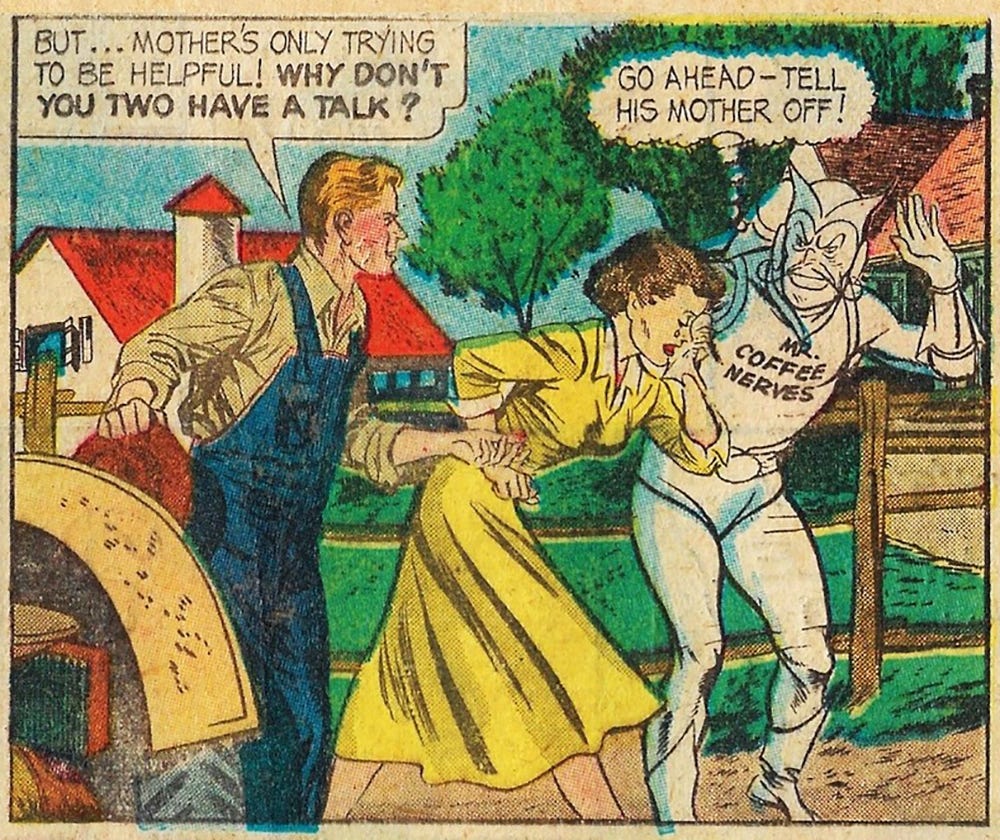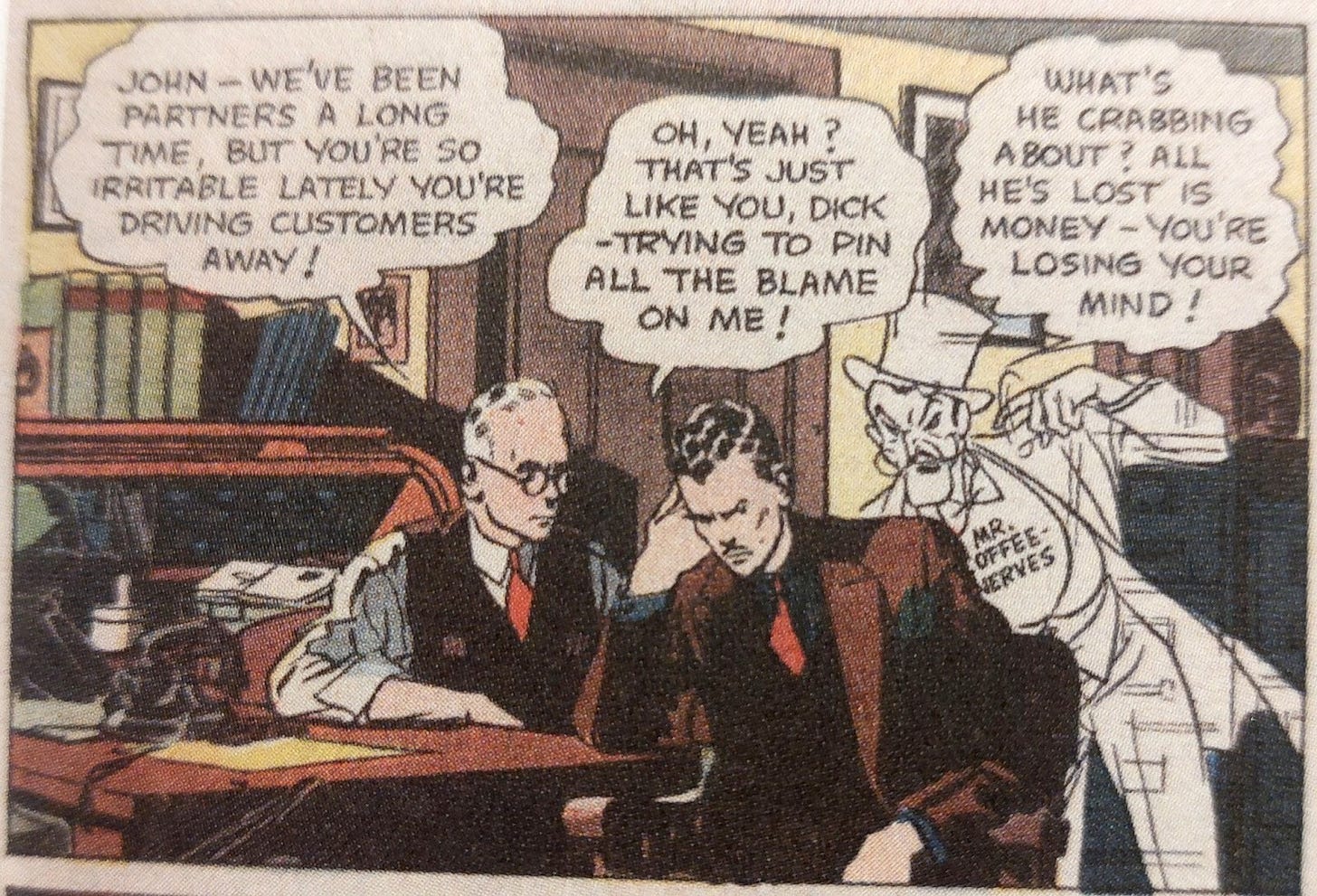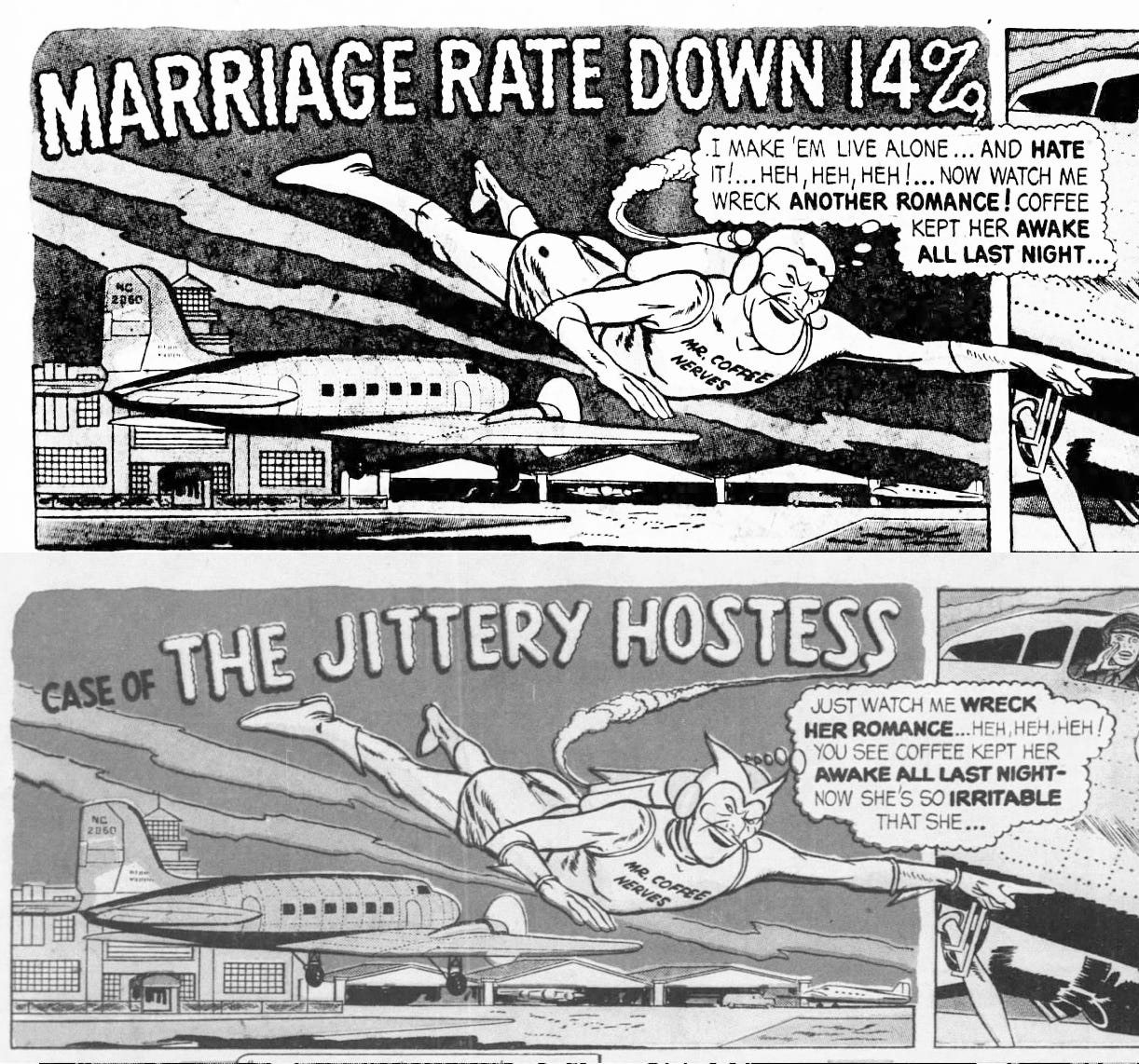Mr. Coffee Nerves: Shoddy Goods 070
FTC thwarts dastardly supervillain!
Somebody send this issue of Shoddy Goods, the newsletter from Meh about consumer culture, to James Gunn, because I’ve found the big bad for his next decade of superhero blockbusters. Jason Toon here with the epic knock-down, nod-off saga of Mr. Coffee Nerves vs. the Federal Trade Commission.
Another family torn apart by addiction to (checks notes) coffee
I love classic advertising mascots, and I especially love the mean and nasty ones who personify whatever problem the product is trying to solve. After I rounded up some of my favorite ad monsters a while ago, one of them stuck with me. Maybe it was his nasty, scowling visage. Maybe it was his sheer malevolence, goading parents into abusing their children and causing serious industrial accidents just for the dark glee of it. Maybe it was his connection to some of the great comics artists, or his run-in with the feds.
Or maybe it’s because I drink at least three cups of strong coffee a day. Whatever it was, Mr. Coffee Nerves got his claws into me, and unlike his victims in the funny papers, no Postum was going to come to my rescue. I can only hope that telling the world his story will finally exorcise this asshole ghost..
What’s he crabbing about?
Postum debuted in 1895 as a coffee substitute created by C.W. Post after ripping off- er, being inspired by fellow health nuts the Kellogg brothers. While I’ve never had the stuff personally, its ingredients list - topped by roasted wheat bran and molasses - doesn’t exactly set my mouth watering. It seems redolent of the crackpot pseudo-scientific circles that Post and the Kelloggs moved in, where anything bland and unappealing must be good for you. Postum is the kind of drink frumpy Facts of Life schoolmarm Edna Garrett and The Simpsons‘ shriveled oligarch C. Montgomery Burns could bond over, if the “In popular culture” section of the Wikipedia page is to be believed.
But Postum was a smash in those less flavorful days, quickly making Post rich and kickstarting the business that would later become Post Cereal Company. Post’s belief in aggressive advertising set the tone for the company, to the point that its most notorious campaign would come two decades after his 1914 death.
Tiddledy-winks? Them’s fightin’ words
It’s not clear who created Mr. Coffee Nerves, the undead embodiment of caffeine jitters. He first appeared in 1934, needling poor coffee drinkers into wrecking their lives before a doctor’s recommendation of Postum got this top-hatted-and-tailed monkey off their backs. What we do know is that the workmanlike early efforts got a major artistic boost in 1936, when Post’s ad agency, Young and Rubicam, hired the comic-strip advertising studio of Johnstone and Cushing onto the account.
In the days before TV, comics were the best way to tell a short visual fable touting your products, and Johnstone and Cushing were at the forefront of the form. They provided commercial side hustles to a Murderer’s Row of cartooning legends, from Dik Browne (Hagar the Horrible) and Stan Drake (The Heart of Juliet Jones) to, later, famed Batman artist Neal Adams.
Mr. Coffee Nerves got two of their best: Milton Caniff and Noel Sickles. They were already informally collaborating on each others’ strips, Terry and the Pirates and Scorchy Smith, respectively. Each was a master of composition, emotion, and character, qualities they brought to their Mr. Coffee Nerves work under the shared pen name “Paul Arthur”.
Customers, shmustomers! I gotta have my Maxwell House!
Sure, they’re just ads for a mass-produced, probably gross instant drink mix. But when Mr. Coffee Nerves tells a guy complaining about his neighbor’s chickens to “kill ‘em and throw ‘em in their front door,” his venomous spite approached something like art.
The ridiculous power of these dramatic mini-vignettes - and the saturation advertising favored by Post - made Mr. Coffee Nerves a household name. Then the campaign came to an abrupt halt when the US entered World War II. Maybe it was unpatriotic to criticize the coffee keeping our GIs awake on the front lines. Or maybe Mr. Coffee Nerves got drafted.
Nag, nag, nag!
When he re-emerged in 1947, Mr. Coffee Nerves had a new look more in keeping with the atomic age, a bizarre space acrobat kind of thing that at some point also acquired what look like horns (?). He had a new artistic team, Don Komarisow and Lou Fine, both longtime veterans of comics and commercial illustration. And he had a new in-your-face approach, citing unsubstantiated statistics of societal collapse and sneeringly giving coffee the credit for every one.
We don’t need no Postum, let the crate of acid burn
From fires to juvenile delinquency, from failed relationships to car crashes, it seems there was no social ill that didn’t bear the stain of the dread coffea arabica. Mr. Coffee Nerves’ sowing of chaos is as depraved as ever, provoking an annoyed mom to kick her rambunctious son out of the house, then encouraging the kid’s shoplifting. When a young couple argues, Mr. Coffee Nerves whispers in the man’s ear, “Nag, nag, nag! Lucky you found out before you married her!”
These hard-hitting, if totally unsourced, new “percentage ads” were so effective, they got too much attention. Specifically, from the Federal Trade Commission, who contacted General Foods (who owned Postum by now) in September, 1948 to raise the question of the veracity of the ads. While the preceding events are lost to history, or at least to me, I can only imagine that the coffee industry had complained to both General Foods and the FTC, because Postum had actually stopped citing the percentages the previous month. Here’s a before-and-after example of how they rewrote the ads to stop just short of making a legal claim:
Blame the falling marriage rate on coffee? Who, us?
In a formal agreement with the FTC in 1951, General Foods agreed “to cease and desist from representing in any manner that the drinking of coffee has an appreciable or pronounced influence on, or on any rate of increase in, divorces, business failures, factory accidents, juvenile delinquencies, traffic accidents, fires, or home foreclosures.” It seems those percentage ads flew too close to the sun with Mr. Coffee Nerves’s unexplained jetpack.
The loss of his statistics didn’t stop Mr. Coffee Nerves from continuing to stir up trouble. But he was losing his mojo as the public taste for comic-strip advertising waned. Into the early ‘50s, his adventures were reduced to single-panel composites, then as the only cartoon presence in a photographic scene. Postum was obliged to add language about how “many people can handle coffee or tea without ill-effect”, diluting the purity of Mr. Coffee Nerves’ wrath. Finally, in 1952, Mr. Coffee Nerves’ cup of spite ranneth dry.
But shed not a tear. For whenever a java’ed-up dad snarls at his angelic son to buzz off, whenever a caffeine-crashing industrial worker spills a giant vat of acid, whenever a coffee-addled apparel salesman mocks a customer’s attempt to return a dress, Mr. Coffee Nerves will be there.
Foiled again - and forever
What’s your coffee habit like? Never touch the stuff, wouldn’t make it out the door without three cups, or somewhere between?
I might be more addicted to my slow, calming pour-over routine each morning than the drink itself - though you’ll take my afternoon Coke Zeros from my cold, dead, moderately caffeinated hands. Join us in this week’s Shoddy Goods chat to discuss all things coffee.
—Dave (and the rest of Meh)
These past stories from Shoddy Goods probably won’t make you spank your kids or crash your car, but hey, no promises:







